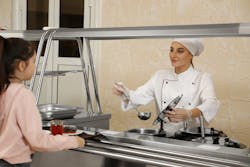The Covid-19 pandemic has disrupted not only classroom instruction for millions of students, but also other elements vital to effective school operations, like transportation and food services.
From coast to coast, school districts are reporting operational problems that go beyond protecting students from the dangerous coronavirus. Many schools say they don’t have enough drivers to operate the buses that carry students to and from campuses, and when those students arrive, schools may not have enough workers to prepare and serve meals to students, or even have enough food to provide adequate meals.
“Supply chain disruptions are making it infinitely more difficult to plan and serve nutritious meals, critical to student health and success," says School Nutrition Association President Beth Wallace. “School nutrition professionals continue to ensure healthy meals are available for students, but perpetually difficult conditions have forced many last-minute menu changes and limited the number of choices in school cafeterias.”
A School Nutrition Association survey in December 2021 of 1,212 school meal program directors shines a light on the extent of the problem in school kitchens and cafeterias.
The survey found that supply chain problems are affecting meal programs in districts of every size and from every part of the nation. The most pressing challenges facing school food service operations are menu items that are not available in sufficient quantities; supplies and packaging not available in sufficient quantities; and menu items that have been discontinued by a manufacturer.
The association says that the supply chain disruptions have forced food service workers to scramble for substitute menu items, search for new vendors when orders are delayed or canceled, and in some cases go to local stores to buy needed food and supplies.
More than 96% of those responding to the survey say the supply chain problems have made it difficult for meal programs to meet federal nutrition standards. Many suppliers do not carry enough whole-grain, low-sodium and low-fat options that would enable schools to meet standards.
The U.S. Department of Agriculture (USDA) issued waivers for 2021-22 so that school affected by the supply chain problems were not penalized for failing to meet standards. The nutrition association says that because of the continued supply shortages, the USDA should extend the waivers through 2022-23.
“Given widespread reports of discontinued K-12 menu items, consolidation in the school nutrition industry and concerns regarding the upcoming bid season, school meal programs will require regulatory relief moving forward,” the association says.
Help wanted
In addition to the difficulties of having the right food options in the right quantities, school meal programs also are plagued with a shortage of workers to prepare and serve food.
Some 95% of survey respondents say staff shortages have been a headache as the pandemic drags on. The problem appears to be worse in large districts (those with more than 25,000 students); 90% of respondents from large districts say staff shortages have posed a “significant challenge.”
“School nutrition staff [are] stretched thin as they struggle to manage orders and re-work menus, which require more staff time and resources,” the association says. “Staff shortages also limit the opportunity to offer more labor-intensive menu options, such as customizable entrées and freshly cut and portioned produce.”
The survey indicates that staff shortages have persisted even as school districts offer incentives to attract workers. About 42% of survey respondents says they have raised salaries for food service workers, and another 15% say they are considering that step. About 19% say they have offered bonuses to workers.
For meal programs that have not offered incentives, 58% of respondents say district administrators have declined to approve raises or bonuses.
Room Service
Because lunchtime in a school cafeteria often results in a crowded mass of hungry bodies gathering in a confined areas, these spaces do not provided the social distancing that is one of the key strategies for inhibiting the spread of Covid-19.
So, many schools are having their students forgo the cafeteria and remain in their classrooms to eat lunch.
The nutrition association has put together a “Meals in the Classroom” guide to help schools establish effective procedures for classroom dining.
Among the tips offered:
- Develop a clear, structured routine and reinforce it regularly.
- Have clear expectations for acceptable student behavior for meals in classrooms.
- Encourage students to take pride and ownership in keeping their space clean.
- Establish routines for students cleaning their space and their hands before and after meals.
- Prepare students to respond calmly to the occasional, and inevitable, spills.
- Have a clean-up caddy accessible and allow students to clean up their own messes.
- Provide students with cues to let them know how much time they have left to finish their meals.
- Include classroom activities and instructional time, when appropriate, as part of meals in classrooms.
- Help students learn the skills of positive mealtime conversations by reviewing appropriate topics, voice level, listening and not talking while chewing.
- Use music and lighting to set a calm and comfortable mood for meals in classrooms.
The Centers for Disease Control and Prevention also has guidance for setting up a classroom to accommodate meals while taking steps to slow the spread of Covid-19. Among the recommendations:
- Students should not eat meals in classrooms unless at least 6 feet of physical distance can be maintained, and ventilation can be improved.
- Open doors and windows as much as you can to bring in fresh outdoor air.
- Place a fan as close as possible to an open window blowing outside.
- Have cleaning products available for wiping food surfaces before and after mealtimes.
- Arrange and mark seats and tables so that students are at least 6 feet apart.
- Place a hand sanitizing station near each door, and touch-free trash cans near exits.
About the Author
Mike Kennedy
Senior Editor
Mike Kennedy, senior editor, has written for AS&U on a wide range of educational issues since 1999.
